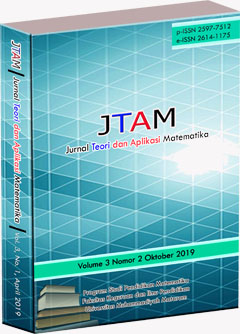| Journal Title | JTAM (Jurnal Teori dan Aplikasi Matematika) |
| Initials | JTAM |
| Frequency | 4 issues per year (January, April, July & October) |
| DOI | prefix 10.31764 by |
| Print ISSN | 2597-7512 |
| Online ISSN | 2614-1175 |
| OAI Address | http://journal.ummat.ac.id/index.php/jtam/oai |
| Editor-in-Chief | Assist. Prof. Dr. Syaharuddin [Scopus ID 57217864595] |
| Status | Accredited (Sinta 2) | No. 0173/C3/DT.05.00/2025 Valid: Volume 8 Issues 2 2024 - Volume 13 Issues 1 2029 |
| Contact | [email protected] |
| Publication | October 2017 |
| Publisher | Universitas Muhammadiyah Mataram |
JTAM (Jurnal Teori dan Aplikasi Matematika) publishes high-quality, peer-reviewed research that bridges theoretical mathematics and interdisciplinary applications. The journal emphasizes the integration of computation, modeling, educational innovation, and cultural perspectives to advance mathematical understanding and its role in sustainable development, digital transformation, and inclusive scientific literacy across global and local contexts. JTAM (Jurnal Teori dan Aplikasi Matematika) focuses on the following research areas:
- Computational and Applied Mathematics. This area covers original research on mathematical modeling, numerical methods, simulation, and computational analysis for solving real-world problems. It includes applied mathematics studies addressing complex systems in physics, engineering, finance, epidemiology, environmental science, and socio-technical systems. Topics include numerical optimization, dynamical systems, computational fluid dynamics, inverse problems, and simulation-based modeling that establish strong links between mathematical theory and practical applications. Emphasis is given to research contributing to algorithmic innovation, computational efficiency, and multidisciplinary modeling frameworks.
- Mathematical Foundations, Modeling, and Analytical Approaches in Data Science, Artificial Intelligence, and Machine Learning. This focus highlights the mathematical and analytical foundations of data-driven technologies. It welcomes studies on the formulation, analysis, and validation of algorithms, hybrid intelligent systems, uncertainty modeling (fuzzy, stochastic, or probabilistic), and optimization theory in AI and machine learning contexts. Particular attention is given to works that connect mathematical rigor with AI innovation, such as explainable AI (XAI), mathematical interpretability of neural models, and analytical guarantees of learning algorithms. Applications include healthcare, climate prediction, economics, cybersecurity, and education.
- Statistical Modeling, Data Analysis, and the Integration of Probabilistic Models with Machine Learning Techniques. This section includes theoretical and applied research in statistics, probability, and stochastic processes, with an emphasis on their integration with modern machine learning methods. Areas of interest include Bayesian inference, time series forecasting, spatial-temporal analysis, uncertainty quantification, and statistical learning theory. The focus is on the fusion of probabilistic and statistical approaches to enhance predictive performance, risk assessment, and data-driven decision-making in complex or uncertain environments.
- Mathematics Education and Technology Integration in Digital Pedagogy and Computational Thinking. JTAM (Jurnal Teori dan Aplikasi Matematika) supports research advancing mathematics education through digital innovation and technology integration. This includes AI-assisted learning, computational literacy, STEM-based learning models, and interactive e-learning systems that enhance students’ reasoning, problem-solving, and creativity. The journal welcomes design-based research, systematic literature reviews, and data analytics in mathematics education, especially those exploring human–machine interaction, digital pedagogy frameworks, and adaptive learning technologies relevant to the 21st-century classroom.
- Ethnomathematics, Mathematical Creativity, and Cultural Integration. This area explores the intersection of mathematics, culture, and creativity, fostering a humanistic perspective in mathematical thought. Research topics include ethnomathematics, culturally responsive pedagogy, mathematical semiotics, and local wisdom-based learning. JTAM (Jurnal Teori dan Aplikasi Matematika) encourages works that link mathematical reasoning to art, architecture, traditional games, and indigenous or Islamic values, promoting a deeper understanding of how mathematical ideas evolve through cultural diversity and human creativity.

Announcements
Call for Paper 2026 |
|
Dear, Lecturer, Researcher, Teacher, etc We invite you to publish the research and development of mathematics in JTAM (Jurnal Teori dan Aplikasi Matematika) in the period: Vol. 10, No. 1, January 2026, [CLOSE] Vol. 10, No. 2, April 2026, [CLOSE] Vol. 10, No. 3, July 2026, [OPEN] Vol. 10, No. 4, October 2026, [OPEN] Please send your full paper (. * doc) via the Register/Login form.
ATTENTION:
------------------------------------------------ Acceptance Rate 2023 = 32% Acceptance Rate 2024 = 40% Acceptance Rate 2025 = 36% ------------------------------------------- |
|
| Posted: 2020-06-05 | |
| More Announcements... |




















.JPG)








.JPG)
.JPG)
.JPG)
.JPG)




2.jpg)
